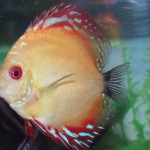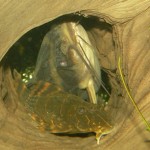Q. I have three luohan fish and two of them have laid numerous eggs. Can you tell me what I should do to ensure that these eggs hatch successfully?
Obviously, you will need a male luohan to fertilize the eggs. You did not say whether you have a true pair or not. Assuming you have, here are my answers.
Sexing Flowerhorn
So, how do you tell male from female? In the olden days, if you see a black patch on the dorsal fin, you can be quite sure that it’s a female. These days, with so much interbreeding of hybrids, a black patch on the dorsal fin may not necessarily indicate a female fish. Other distinguishing physical features are that males tend to be bigger and broader, and they have more prominent head bumps.
The only accurate way to differentiate the sex of the luohan is to look out for their ovipositors. When the female and male are ready to spawn, they will drop their ovipositors. In the male, the shape is slender and ends in a sharper angle. The female’s tube is thicker and tends to end in a flatter angle.
Before Breeding Flowerhorn
Prior to a pair of fish together, it would be a good idea to introduce them to each other by housing them in the same tank, while keeping them separate from each other with an acrylic partition.
If you are using a power driven filter system, it’s best to introduce a sponge filter at this time (this will be used when the eggs begin to hatch fry).
In order to get a bigger spawn, a high rate of fertilization and healthy fry, you need to condition both parents well prior to the actual spawning. The best type of food to bring out the conditions fast is live food. Of course, feeding a higher protein live diet means you have to spend more time maintaining the water quality.
During Breeding
When a male is displaying a courtship dance, it will make its body “shiver” and shake its head to and fro in quick tempo to attract and induce the female to accept it. When the tubes start dropping from both parents, the time has come to remove the partition to allow spawning to take place. At this moment, it’s crucial for you to have good judgment of fish behavior and nerves of steel.
If it’s a match made in heaven, there will be little fighting, I have seen how some pairs of fish of the tail, and the pairs happily swim off to inspect and clean a spawning site. By the way, locking lips (fighting fish style) is common, so do not be alarmed if this happens.
Others will literally bite each other and inflict heavy wounds before settling down, there is really no way of telling. But one obvious sign that the match has failed is when one fish ends up chasing the other all over the tank.
After Breeding
You must stay and observe a newly introduced pair for at least 15 minutes to ascertain their suitability. If a successful spawning does take place, you can either leave the parents to guard the eggs or move them to another tank.
If you remove the parents, it is also a good idea to introduce some methyl blue to prevent fungus growing on the eggs. If the parents are not removed, just feed them sparingly in order to maintain the water quality.
When the tails of the fry start protruding out of the “shell,” switch off all motor-driven pumps. Otherwise, the fry will be sucked in. Leave the sponge filter on for the next few weeks, and maintain it well by washing it with the tank water frequently.
Feed the young with ready-prepared food from the pet shops. Once they are free-swimming, you can start removing the parents to another tank. Good luck!
















